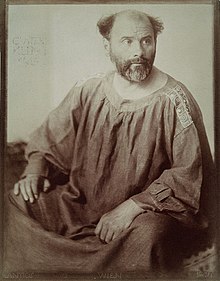
Back Gustav Klimt Afrikaans Gustav Klimt ALS Gustav Klimt AN غوستاف كليمت Arabic جوستاف كليمت ARZ Gustav Klimt AST Qustav Klimt Azerbaijani Gustav Klimt BAR Густаў Клімт Byelorussian Густаў Клімт BE-X-OLD
Gustav Klimt | |
|---|---|
 Photographic portrait from 1914 | |
| Born | 14 July 1862 |
| Died | 6 February 1918 (aged 55) |
| Known for | Painter |
| Notable work | Judith and the Head of Holofernes, Portrait of Adele Bloch-Bauer I, The Kiss, Danaë |
| Movement | Symbolism, Art Nouveau, Vienna Secession |
| Partner | Emilie Louise Flöge |
| Signature | |
 | |
Gustav Klimt (14 July 1862 – 6 February 1918) was an Austrian symbolist painter and one of the most prominent members of the Vienna Secession movement. Klimt is noted for his paintings, murals, sketches, and other objets d'art. Klimt's primary subject was the female body,[1] and his works are marked by a frank eroticism.[2] Amongst his figurative works, which include allegories and portraits, he painted landscapes. Among the artists of the Vienna Secession, Klimt was the most influenced by Japanese art and its methods.[3]
Early in his career, he was a successful painter of architectural decorations in a conventional manner. As he began to develop a more personal style, his work was the subject of controversy that culminated when the paintings he completed around 1900 for the ceiling of the Great Hall of the University of Vienna were criticized as pornographic. He subsequently accepted no more public commissions, but achieved a new success with the paintings of his "golden phase", many of which include gold leaf. Klimt's work was an important influence on his younger peer Egon Schiele.
Since the 1990s, he has been one of the artists whose paintings fetch top prices at auctions.[4]
- ^ Fliedl 1994, p. 14. The most important element of his fame is his reputation as a master of eroticism.
- ^ Sabarsky 1983, p. 18.
- ^ Sotheby's: Gilded Romance: Gustav Klimt's Ornamental Style and the Influence of Japonisme, 19 June 2019
- ^ Daily Art Magazin: 5 Facts You Need to Know About Gustav Klimt, 25 January 2022